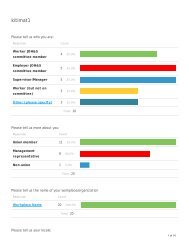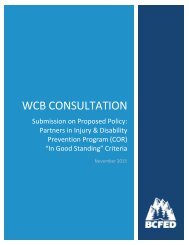KITIMAT DRAFT Report
You also want an ePaper? Increase the reach of your titles
YUMPU automatically turns print PDFs into web optimized ePapers that Google loves.
Situational Awareness<br />
Situational awareness is the perception of environmental elements within a volume of time and space, the<br />
comprehension of their meaning and the projection of their status in the near future. Situational awareness<br />
<strong>DRAFT</strong><br />
involves being aware of what is happening around you to understand how information, events and your<br />
own actions will impact your goals and objectives, both now and in the near future.<br />
Situational awareness means that a human appropriately responds to important informational cues. This<br />
definition contains four key elements: (1) humans, (2) important informational cues, (3) behavioural cues,<br />
and (4) appropriateness of the responses. Important informational cues refer to environmental stimuli that<br />
are mentally processed by the human. The appropriateness of the responses implies the comparison of the<br />
response with an expected response or a number of possible expected responses. Expected responses form<br />
the basis for a performance measure of situational awareness.<br />
While situational awareness can be defined as a state of knowledge, a situational assessment can<br />
be described as a process used to achieve that state. It refers to the process of achieving, acquiring or<br />
maintaining situational awareness.<br />
Therefore, situational awareness is viewed as “a state of knowledge” and a situational assessment as “the<br />
processes” used to achieve that knowledge.<br />
The following “Situational Assessment Survey” will be used to evaluate the effectiveness of the workplace’s<br />
return-to-work practices and recommend effectual actions to improve outcomes.<br />
There are 12 areas (attributes) that are explored by the “Situational Assessment Survey”. They are:<br />
1. Commitment Policy/RTW Policy 7. Linking Primary and Secondary Prevention<br />
2. Injury/Absence <strong>Report</strong>ing Procedures 8. Utilization of Disability Prevention Principles<br />
3. Early Contact & Intervention 9. Compliance with Human Rights<br />
4. Cooperative RTW Responsibilities 10. Mobilization of RTW Leadership<br />
5. Elimination of Attitudinal Barriers 11. Internal Dispute Resolution Mechanism<br />
6. Transfer of Medical Information 12. RTW Program Evaluation<br />
This first phase of review relies on subjective data gathered by survey questions that are intended to reflect<br />
the perceptions and experiences of the current RTW practices. The attributes, survey questions and data<br />
analysis are consistent with the most current return-to-work, evidence-based practices and research.<br />
The last area of review relies on objective data that will assist to determine the workplace’s retrospective<br />
performance indicators.<br />
Situational assessment<br />
District of Kitimat<br />
3





